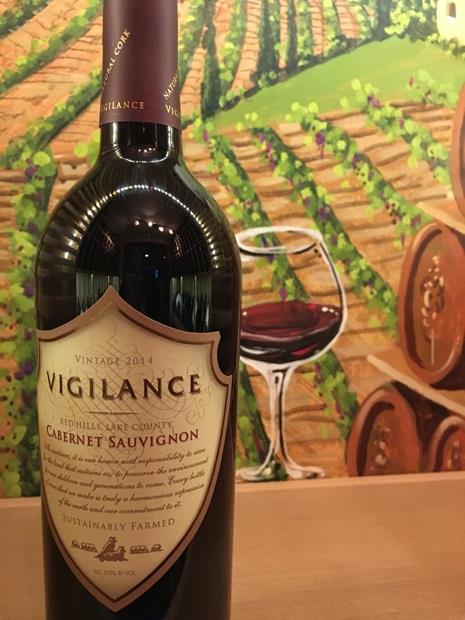
External search
Google (images)
Wine Advocate
Wine Spectator
Burghound
Wine-Searcher
Vintages
2020
2019
2018
2017
2016
2015
2014
2013
2012
2011
2010
2009
2008
2007
From this producer
Show all wines
All tasting notes
|
| Drinking Windows and Values |
| Drinking window: Drink between 2017 and 2021 (based on 14 user opinions) |
| Community Tasting History |
| Community Tasting Notes (average 85 pts. and median of 85 pts. in 4 notes) - hiding notes with no text | | | Tasted by Richard123 on 6/2/2017 & rated 85 points: OK, but rather manufactured in flavor. Not worth the cost. (1324 views) | | | Tasted by TottenCellars on 3/3/2017: 2 of 2 bottles for review from my sonoma trip a couple weeks back. I have seen this on store shelves before at a fairly low price point so I wasn't sure what to expect. I also had very few lake county wines and no cabernet that I can recall.
Color is a medium red, which looks a little on the light side for a cabernet. The wine is free of sediment. with the PNP I got a very moderate by young nose but was a bit nondescipt. I noted red fruit with a bit of blackberry, some oak but it doesn't seem to add anything or take away from the wine. I felt it resembled a cabernet in that blind tasting I would pick out as a cab but would have an impossible time with any other details.
Drinking it it comes across dry and medium bodied medium drying tannins and a good amount of acidity. The balance between all these elements seemed good. Nothing stuck out either good or bad. I again got blackberry some oak and strangely enough pomegranate. Pomegranate is a note I associate with Pinot Noir and even more so a lighter style Grenache not typically Cabernet. I enjoyed the overall flavors in the wine more than the nose. The finish was medium length and showed the nice juicy acidity that I like. It really seemed like a better food wine than a sipper. And at the price point that makes sense.
After being open for several hours it did pick up a slight jamminess.
Conclusion.
Not a wine I would necessarily seek out but not bad in any way. Alcohol and oak are under control, its a bit generic but has the qualities to make it a nice dinner wine.
Style, I would place it somewhere in between new and old world. It doesn't have the huge over the top profile of a modern napa cab but it definitely tastes like a California cab. (1385 views) | | | Tasted by stags22 on 2/4/2017: Not a very good QPR, so at $12 (and I got this bottle for free), 'nuff said. (1210 views) |
| Vigilance Producer websiteCabernet SauvignonCabernet Sauvignon is probably the most famous red wine grape variety on Earth. It is rivaled in this regard only by its Bordeaux stablemate Merlot, and its opposite number in Burgundy, Pinot Noir. From its origins in Bordeaux, Cabernet has successfully spread to almost every winegrowing country in the world. It is now the key grape variety in many first-rate New World wine regions, most notably Napa Valley, Coonawarra and Maipo Valley. Wherever they come from, Cabernet Sauvignon wines always seem to demonstrate a handful of common character traits: deep color, good tannin structure, moderate acidity and aromas of blackcurrant, tomato leaf, dark spices and cedarwood.
Used as frequently in blends as in varietal wines, Cabernet Sauvignon has a large number of common blending partners. Apart from the obvious Merlot and Cabernet Franc, the most prevalent of these are Malbec, Petit Verdot and Carmenere (the ingredients of a classic Bordeaux Blend), Shiraz (in Australia's favorite blend) and in Spain and South America, a Cabernet – Tempranillo blend is now commonplace. Even the bold Tannat-based wines of Madiran are now generally softened with Cabernet SauvignonUSAAmerican wine has been produced since the 1500s, with the first widespread production beginning in New Mexico in 1628. Today, wine production is undertaken in all fifty states, with California producing 84% of all U.S. wine. The continent of North America is home to several native species of grape, including Vitis labrusca, Vitis riparia, Vitis rotundifolia, and Vitis vulpina, but the wine-making industry is based almost entirely on the cultivation of the European Vitis vinifera, which was introduced by European settlers. With more than 1,100,000 acres (4,500 km2) under vine, the United States is the fourth-largest wine producing country in the world, after Italy, Spain, and France.California2021 vintage: "Unlike almost all other areas of the state, the Russian River Valley had higher than normal crops in 2021, which has made for a wine of greater generosity and fruit forwardness than some of its stablemates." - Morgan Twain-Peterson North CoastThe North Coast American Viticultural Area (AVA) in California, covering more than three million acres, includes Napa, Sonoma, Mendocino and Lake counties, and portions of Marin and Solano counties. (see The Wine Institute for more information)Red Hills Lake County Federal Register entry establishing the "Red Hills Lake County" Viticultural Area. The "Red Hills Lake County" AVA is entirely within the "Lake County" AVA. |
|




